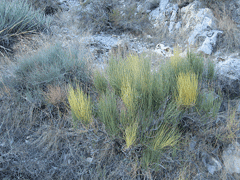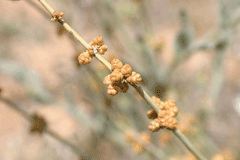 |
|
http://flickr.com/photos/16921893%40N00/ |
 |
| http://www.flickr.com/people/38213125@N00 |
Translate this page:
Summary
Physical Characteristics

 Ephedra nevadensis is an evergreen Shrub growing to 1.2 m (4ft).
Ephedra nevadensis is an evergreen Shrub growing to 1.2 m (4ft).
See above for USDA hardiness. It is hardy to UK zone 6. It is in leaf all year, in flower from April to June. The species is dioecious (individual flowers are either male or female, but only one sex is to be found on any one plant so both male and female plants must be grown if seed is required). . The plant is not self-fertile.
Suitable for: light (sandy) and medium (loamy) soils and prefers well-drained soil. Suitable pH: mildly acid, neutral and basic (mildly alkaline) soils. It cannot grow in the shade. It prefers dry or moist soil and can tolerate drought.
UK Hardiness Map
US Hardiness Map
Synonyms
Plant Habitats
Cultivated Beds;
Edible Uses
Edible Parts: Fruit Seed
Edible Uses: Tea
Fruit - raw. A sweet but very mild flavour[K]. Seed - cooked[22, 46, 105, 161, 257]. A bitter taste[92]. It can be roasted and ground into a powder and used to make a bread or mush[183]. A delicious tea is made by steeping the green or dried twigs in boiling water until they turn an amber or pink colour[21, 92, 95, 105, 161, 183].
References More on Edible Uses
Medicinal Uses
Plants For A Future can not take any responsibility for any adverse effects from the use of plants. Always seek advice from a professional before using a plant medicinally.
Blood purifier Diuretic Febrifuge Poultice Tonic VD
The stems are blood purifier, diuretic, febrifuge and tonic[22, 46, 61, 257]. They are beneficial in the treatment of urogenital complaints[22, 46, 61]. An infusion has been used in the treatment of kidney problems, gonorrhoea and the first stages of syphilis[257]. A poultice of the powdered stems has been applied to sores[257]. The stems of most members of this genus contain the alkaloid ephedrine and are valuable in the treatment of asthma and many other complaints of the respiratory system[K]. The whole plant can be used at much lower concentrations than the isolated constituents - unlike using the isolated ephedrine, using the whole plant rarely gives rise to side-effects[254]. Ephedra does not cure asthma but in many cases it is very effective in treating the symptoms and thus making life somewhat easier for the sufferer. The stems can be used fresh or dried and are usually made into a tea, though they can also be eaten raw[K]. The young stems are best if eating them raw, though older stems can be used if a tea is made[K]. The stems can be harvested at any time of the year and are dried for later use[238].
References More on Medicinal Uses
The Bookshop: Edible Plant Books
Our Latest books on Perennial Plants For Food Forests and Permaculture Gardens in paperback or digital formats.

Edible Tropical Plants
Food Forest Plants for Hotter Conditions: 250+ Plants For Tropical Food Forests & Permaculture Gardens.
More

Edible Temperate Plants
Plants for Your Food Forest: 500 Plants for Temperate Food Forests & Permaculture Gardens.
More

More Books
PFAF have eight books available in paperback and digital formats. Browse the shop for more information.
Shop Now
Other Uses
References More on Other Uses
Cultivation details
Requires a well-drained loamy soil and a sunny position[1, 11]. Established plants are drought resistant and are also lime tolerant[200]. Dioecious. Male and female plants must be grown if seed is required.
References Carbon Farming Information and Carbon Sequestration Information
Temperature Converter
Type a value in the Celsius field to convert the value to Fahrenheit:
Fahrenheit:
The PFAF Bookshop
Plants For A Future have a number of books available in paperback and digital form. Book titles include Edible Plants, Edible Perennials, Edible Trees,Edible Shrubs, Woodland Gardening, and Temperate Food Forest Plants. Our new book is Food Forest Plants For Hotter Conditions (Tropical and Sub-Tropical).
Shop Now
Plant Propagation
Seed - best sown as soon as it is ripe in the autumn in a greenhouse[200]. It can also be sown in spring in a greenhouse in a sandy compost[K]. Prick out the seedlings into individual pots as soon as they are large enough to handle and grow them on for at least their first winter in a greenhouse. Plant out in the spring or early summer after the last expected frosts and give some protection in their first winter[K]. Division in spring or autumn[238]. Layering.
Other Names
If available other names are mentioned here
Squaw tea, Nevada jointfir, Canatillo, Desert tea, Popatillo,
Native Range
NORTHERN AMERICA: United States (Oregon, Arizona, California, Nevada, Utah)
Weed Potential
Right plant wrong place. We are currently updating this section.
Please note that a plant may be invasive in one area but may not in your area so it's worth checking.
Conservation Status
IUCN Red List of Threatened Plants Status :

| Related Plants
|
| Latin Name | Common Name | Habit | Height | Hardiness | Growth | Soil | Shade | Moisture | Edible | Medicinal | Other |
| Ephedra altissima | High-climbing jointfir | Shrub | 0.0 |
0-0
| | LM | N | DM | 1 | 3 | |
| Ephedra americana andina | | Shrub | 1.8 |
5-9
| | LM | N | DM | 2 | 3 | 3 |
| Ephedra ciliata | | Shrub | 0.2 |
-
| | LM | N | DM | 1 | 3 | |
| Ephedra distachya | Sea Grape, Jointfir | Shrub | 1.0 |
5-9
| | LM | N | DM | 2 | 4 | 3 |
| Ephedra equisetina | Muzei Ma Huang, Ma huang | Shrub | 1.5 |
0-0
| | LM | N | DM | 1 | 4 | |
| Ephedra fragilis | | Shrub | 1.8 |
7-10
| | LM | N | DM | 2 | 4 | |
| Ephedra gerardiana | Ma Huang, Gerard jointfir | Shrub | 0.6 |
6-9
| | LM | N | DM | 2 | 4 | 3 |
| Ephedra intermedia | Zhong Ma Huang | Shrub | 1.0 |
5-9
| | LM | N | DM | 1 | 4 | |
| Ephedra major | Ma Huang | Shrub | 2.0 |
5-9
| | LM | N | DM | 1 | 4 | |
| Ephedra pachyclada | | Shrub | 0.0 |
-
| | LM | N | DM | 2 | 3 | |
| Ephedra sinica | Ma Huang, Chinese ephedra | Shrub | 0.4 |
0-0
| | LM | N | DM | 1 | 4 | |
| Ephedra torreyana | Mexican Tea, Torrey's jointfir | Shrub | 1.0 |
0-0
| | LM | N | DM | 2 | 3 | |
| Ephedra triandra | | Shrub | 0.0 |
-
| | LM | N | DM | 1 | 3 | |
| Ephedra trifurca | Longleaf Jointfir | Shrub | 2.0 |
-
| | LM | N | DM | 1 | 2 | |
| Ephedra viridis | Mormon Tea, Brigham Tea, Long Leaf Ephedra, Mountain Joint Fir, Mormon Tea, Ephedra | Shrub | 1.8 |
6-11
| | LM | N | DM | 2 | 3 | 1 |
|
Growth: S = slow M = medium F = fast. Soil: L = light (sandy) M = medium H = heavy (clay). pH: A = acid N = neutral B = basic (alkaline). Shade: F = full shade S = semi-shade N = no shade. Moisture: D = dry M = Moist We = wet Wa = water.
Now available:
Food Forest Plants for Mediterranean Conditions
350+ Perennial Plants For Mediterranean and Drier Food Forests and Permaculture Gardens.
[Paperback and eBook]
This is the third in Plants For A Future's series of plant guides for food forests tailored to
specific climate zones. Following volumes on temperate and tropical ecosystems, this book focuses
on species suited to Mediterranean conditions—regions with hot, dry summers and cool, wet winters,
often facing the added challenge of climate change.
Read More
Expert comment
Author
S.Watson.
Botanical References
171270
Links / References
For a list of references used on this page please go here
Readers comment
| Add a comment |
|
If you have important information about this plant that may help other users please add a comment or link below. Only comments or links that are felt to be directly relevant to a plant will be included. If you think a comment/link or information contained on this page is inaccurate or misleading we would welcome your feedback at [email protected]. If you have questions about a plant please use the Forum on this website as we do not have the resources to answer questions ourselves.
* Please note: the comments by website users are not necessarily those held by PFAF and may give misleading or inaccurate information.
To leave a comment please Register or login here All comments need to be approved so will not appear immediately.
|
Subject : Ephedra nevadensis
|
|
|
|